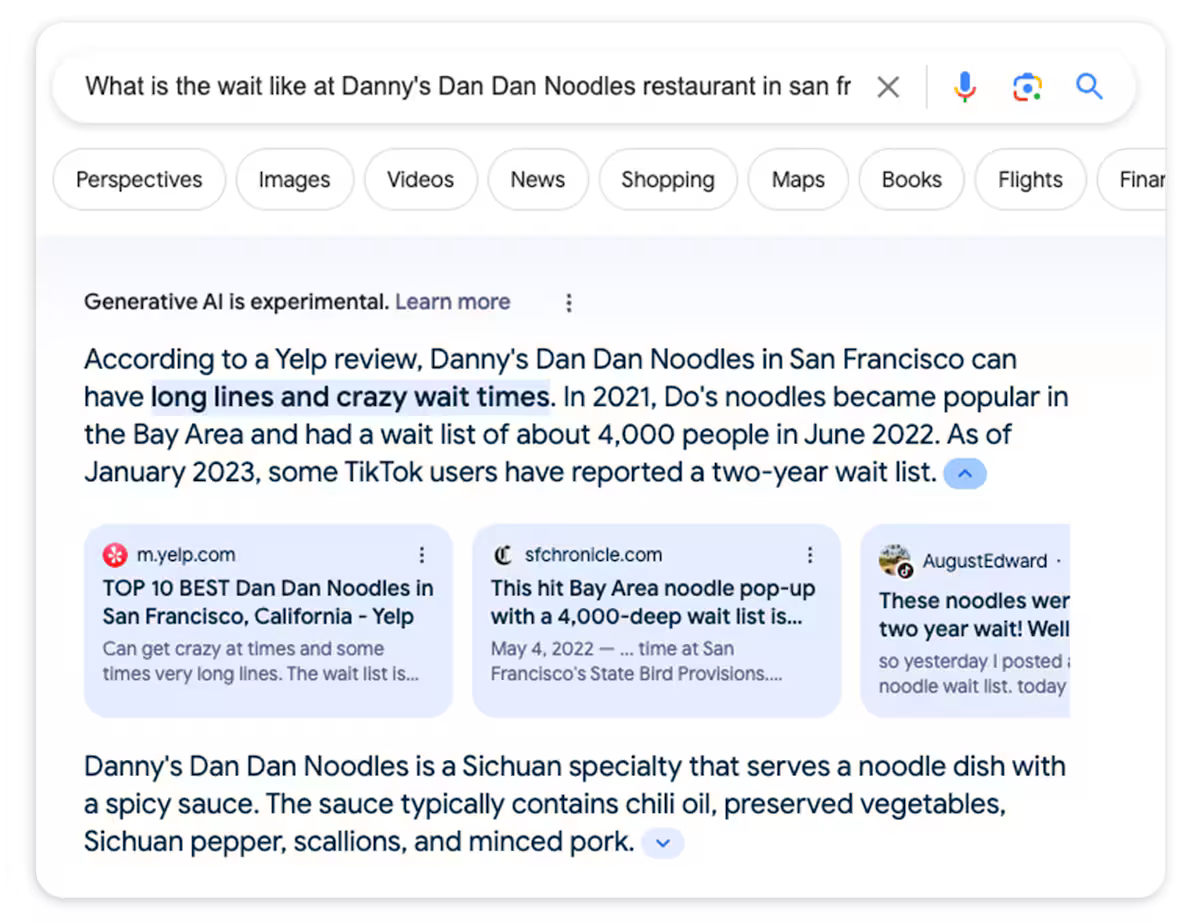
What Marketers Need to Know About Google’s AI Overviews
What Marketers Need to Know About Google’s AI Overviews
Danny Shepherd, CEO • Intero Digital • May 14, 2024
The Highlights
- Google has rolled out AI Overviews, which serves up AI-generated overviews of U.S. search results.
- Thanks to this update, Google Search will be able to offer searchers multistep reasoning for more complex queries.
- There are some ways marketers can improve the likelihood that AI Overviews includes the best information in its summaries.
Google’s latest innovation, AI Overviews (also known as Search Generative Experience, or SGE), is making waves. This cutting-edge technology that was just released has the potential to redefine how we interact with search engines. Google is rolling out this generative AI to all U.S. search queries, which is estimated to cover more than 80% of search queries across the majority of verticals.
Unlike traditional search models that direct users to a list of links, AI Overviews aims to be the destination itself by providing AI-powered summaries of what it believes the user is looking for. It’s not just about finding information anymore; it’s about understanding searchers’ intent and delivering the information in a concise, easy-to-consume format.
The Pros and Cons of AI Overviews
Like any new artificial intelligence, AI Overviews has both its upsides and downsides.
On the plus side, AI Overviews can offer an enhanced user experience by providing quick, summarized answers to searchers’ queries, making information consumption faster and more efficient. It can also reduce information overload by summarizing search results and, in turn, reducing how often searchers have to sift through multiple webpages to find what they’re looking for. And when the AI performs well, there’s the potential for increased accuracy, as AI Overviews can reference multiple sources at once to put together its summarized answers.
On the flip side, the generative AI offers limited exposure for brands. Because the information is being summarized, users might have fewer reasons to click through to a website, potentially reducing organic traffic. What’s more, brands might experience a loss of control over search results and find it challenging to make sure the AI selects the most accurate and representative information about their offerings. Brands could even see their organic traffic drop by anywhere from 20% to 60%.
There’s also the potential for outdated, incomplete, or inaccurate information because the accuracy of AI-generated summaries is contingent on the data available and its own judgment when selecting which webpages to review and what information to include. For example, according to a The Washington Post article: “[AI Overviews] all too happily made up information about something that doesn’t even exist. I asked about a San Francisco restaurant called Danny’s Dan Dan Noodles [that doesn’t exist], and it told me it has ‘crazy wait times’ and described its food.”

Finally, some might find themselves displaced in branded search due to suggested next queries or competitors ranking as a source for your brand information, so even if you’re ranking well in organic and AI Overviews, you can lose a click due to users getting distracted.
Case Study: AI Overviews Optimization in Action
Let’s dive into an example of AI Overviews pulling information that’s technically correct but might not be the most representative of the way a brand wants to be portrayed to its audience.
For one of our clients, a high-end appliance repair company, the generative AI was pulling information from the website designer’s website and linking to that below the AI-generated description instead of pulling from and linking to our client’s website.
Why did AI Overviews think the web designer’s site was a better representation of what the client offered than the client’s own website?
Because the web design company prominently included a succinct, direct description of our client and the services they offer — the client’s website didn’t share this type of information with visitors until they scrolled far down on the homepage, and even there, the information wasn’t as direct or concise.
While we can’t directly tell AI Overviews where to pull information from and which information to pull, we can optimize website copy to make it more likely that Google will pull the right information from the right place.
For this client, we added a single sentence near the top of the homepage that clearly, concisely, and prominently says what the client does and who the client serves.
After making that one change, we were able to change Google’s mind, and now the generative AI more often quotes the client’s own website instead of the web design company’s site.
Grant Effinger, a strategist manager for Intero Digital, put it this way: “In content, we all get obsessed with speaking in a way that takes the user on a journey, and we end up losing the crux of the matter, which is ‘What do you do?’ Just say it simply.”
He went on to say: “This isn’t in Google’s best practices. They say to keep doing what you’re doing and create good content. But we know how Google eats content and what it’s looking for, so something as simple as including one sentence at the top of a homepage saying, ‘This is what we’re called, this is what we do, and this is who we do it for,’ can help considerably in terms of visibility in AI Overviews.”
In content, we all get obsessed with speaking in a way that takes the user on a journey, and we end up losing the crux of the matter, which is ‘What do you do?’ Just say it simply.
— Grant Effinger, Strategist Manager • Intero Digital
Leveraging AI Overviews for Enhanced SEO Strategies
To steer AI Overviews in the right direction, brands can adopt a few key tactics:
- Content clarity and consistency: Ensure all online content, from website pages to social media profiles, clearly and consistently communicates your brand’s core message and services. While brand voice, tone, and messaging are still important, being overly verbose or flowery can cause Google to not understand your content as clearly as if you would have just mentioned what you do and areas you serve as clearly as possible and as high up on the homepage as possible.
- Structured data markup: Utilize schema markup to help Google’s AI understand the context and specifics of your content, improving the accuracy of AI-generated summaries.
- Engagement and authority building: Continue to produce engaging, authoritative content that answers your audience’s questions comprehensively. This not only aids Google’s understanding, but also establishes your brand as a go-to source.
- Google Knowledge Graph: This is a popular citation source for AI Overviews. The database gives the large language models that power AI Overviews data points to use in AI-generated search results. Getting into Google Knowledge Graph isn’t as simple as applying — you have to get Google to recognize your business as an entity, and then it will generate a Google Knowledge Panel. To increase the likelihood that you’ll be recognized, make sure your website has a homepage and “About Us” page, create social media profiles, use organization schema markup, link to your homepage or “About Us” page on your social media profiles, and create high-quality on-site content to attract backlinks from other reputable websites.
- High-quality visuals: It can be advantageous to tap into image SEO and video SEO because AI Overviews sometimes includes images (and links to the sites that host those images) when they’re relevant.
The Future of SEO in an AI-Dominant Landscape
Thanks to the release of AI Overviews, we can anticipate significant changes in SEO strategies. Brands will need to focus on being the best answer, not just the first one listed. This could lead to a more level playing field where high-quality content and clear, concise information take precedence over traditional SEO tactics.
We can also anticipate updates to AI Overviews itself that will be important to monitor, including:
- Adjustable overviews to simplify the language or provide additional details.
- Multistep reasoning for complex queries.
- Planning capabilities for tasks such as meal prep or vacations.
- AI-organized SERPs to explore ideas and find inspiration.
- Visual search through uploaded images and videos.
By embracing this change and optimizing for generative AI, brands can secure their place in this new landscape, turning potential challenges into opportunities for growth and engagement. The key to success in an AI-dominant future lies in understanding this technology’s nuances and leveraging it to enhance brand visibility and connection with the target audience. As we look forward, staying informed, adaptable, and proactive will be crucial for navigating the exciting possibilities that Google’s generative AI can bring.
